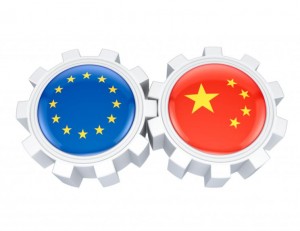 [1]The European Union And China On The New Silk Roads
[1]The European Union And China On The New Silk Roads
By Romano Prodi and David Gosset on The World Post [2] of October 16th, 2015
The complex but irreversible integration of the European continent and the renaissance of the Chinese civilization arguably constitute the most significant factors of change of our time, the wise articulation of these two processes can only be mutually enriching and a source of growth and stability for our global village.
The 40th anniversary [3] of the establishment of diplomatic relations between the European Union and China is an occasion to acknowledge the unprecedented richness of the Eurasian links but also to present, in a time of rapid changes, the ways to reverse the diminishing significance of the Sino-European relationship in comparison with the dynamics connecting other centers of power.
Forty years ago, when the European Community established diplomatic relations with the People’s Republic of China (PRC), it was an association of nine nations evolving in a bipolar world marked by the rivalry between the US and the USSR. In four decades the map of Eurasia has been profoundly transformed, what has become the European Union (EU) one year after the collapse of the USSR is composed of 28 member states which form the world’s largest economic bloc [4], while China, the new economic powerhouse on the planet, is gradually regaining a position of centrality [5] within an increasingly multipolar global system.
With a two-way trade worth € 467 billion last year the relations between Beijing and Brussels are characterized by an unprecedented economic interdependence, the EU is, indeed, the PRC’s top trading partner and China is, after the United States of America, the EU’s second business counterpart.
Economic interactions are complemented by numerous official dialogues covering a wide range of issues from intellectual property rights to urbanization or environment and dense people-to-people exchanges, while the “EU-China 2020 Strategic Agenda for Cooperation” and the perspective of an agreement on investment can give the impression of a highly dynamic partnership carefully cultivated by both sides.
However, the just appreciation of what has been accomplished should not distract from the changes within the two regions already impacting the way they view and treat each other.
As shown by the EU’s incapacity, a decade ago, to lift an anachronistic arms embargo toward Beijing but also by the failure of what was a far-sighted attempt to develop Sino-European cooperation in the field of global navigation satellite system [6], it has often been difficult for Brussels to implement a genuinely autonomous policy toward the Middle Country.
In the conduct of its global diplomacy Beijing has integrated the fact that, for the foreseeable future, a group composed of 28 members will not be able to carry out a truly independent foreign policy.
If the EU’s lack of cohesiveness has diminished the effectiveness of Brussels’ power, the rise of Eurosceptism in the post 2008 financial crisis affects the EU’s very capacity to initiate actions [7]. Dealing with such intrinsic limitations and what increasingly looks like an inoperative EU, the US stands as Beijing’s main interlocutor on strategic issues, and, as far as Europe is concerned, China has reactivated the relations with the EU’s member states certainly satisfying Berlin, Paris, London or Rome but contributing to the eclipse of Brussels.
No major disputes complicate the exchanges between the two continents since it is the relatively balanced Sino-German business relations representing 30% of the total Sino-European trade which dominate the EU-China economic links. The Sino-European relations are solidly anchored in what can be called the Berlin-Beijing special relationship but they are also increasingly in its shadow. Germany, Europe’s reluctant leader, will not transform itself beyond EU [8]‘s borders into an enthusiastic conductor of a trans-continental orchestra.
Large Sino-European trade but also China’s support of the Euro since it entered in circulation and Beijing’s continuing confidence in the eurozone throughout the worst moments of the Greek sovereign debt crisis, create a striking disproportion between the economic and financial weight of the EU-China relations and their political and strategic lightness or quasi irrelevance.
If the promise of the emergence of Brussels as an independent center of political power did not materialize, the perception of Beijing in the eyes of Brussels is also evolving. Preoccupied in its east by the situation in Ukraine [9] and its effects on the EU-Russia relations, concerned by the political disorder in its south generating migratory pressures [10] and challenged from within by the persistent fragilities of the eurozone and the uncertainties incurred by the UK in-out referendum [11], Brussels has turned her attention inward. In this situation the risk is that Beijing does not stand any more as one of the EU’s top priorities, the Chinese economic slowdown even indirectly reinforcing Brussels’ “pivot to Europe”.
For the EU, to de-prioritize Beijing would be an enormous mistake: short term fluctuations [12] are not long term trends, and European strategists should remain focus on the idea that by 2050 the Chinese economy will be twice the size of the American economy. The indispensable elements for a new momentum in the EU-China relations are trade facilitation, the construction of the New Silk Road and the exploration of a New Digital Silk Road.
An agreement on investment is clearly needed but EU-China trade can also be boosted by the gradual mutual opening of the two markets. The Trans-Pacific Partnership (TPP) will facilitate trade among twelve Pacific Rim countries and China, having signed free trade agreements with several TPP members, will indirectly benefit from the reinvigorated trans-pacific economic exchanges.
In parallel with the advancement of the TPP, the EU and the US are negotiating the Transatlantic Trade and Investment Partnership (TTIP). While conditions are created for the trans-Pacific and transatlantic trades to intensify, the two edges of the Eurasian continent should enter talks to open a new chapter in their economic exchanges. Following more than three decades of “reform and opening-up” the Middle Country has become the factory of the world but it is also the market of the world which offers the European exporters unprecedented opportunities.
 [13]China’s President Xi Jinping has structured his global diplomatic action around the New Silk Road strategy [14] with the objective of upgrading the connectivity across Eurasia and the Indian Ocean. Beijing and Brussels have to create the political and financial conditions for the Chinese and European companies to co-build the infrastructures under the “One Belt, One Road” vision.
[13]China’s President Xi Jinping has structured his global diplomatic action around the New Silk Road strategy [14] with the objective of upgrading the connectivity across Eurasia and the Indian Ocean. Beijing and Brussels have to create the political and financial conditions for the Chinese and European companies to co-build the infrastructures under the “One Belt, One Road” vision.
Besides the New Silk Road Fund, the Asian Infrastructure Investment Bank [15] (AIIB) and the New Development Bank, China and the EU could initiate a Sino-European New Silk Road Fund.
If Brussels is unable to answer the Beijing’s call to build the New Silk Road, China will pursue her goal alone or with other pro-active partners and the EU will rapidly find herself at the periphery of an economic and diplomatic network designed and realized on the terms of the Middle Country.
Strong EU-China cooperation in the framework of the New Silk Road offers the perspective of new dynamics in Africa. While the two edges of the ancient Silk Road were Europe and China, the New Silk Road connects Asia’s Far East and Africa, seen by many in Beijing as the continent of the future. By entering a strategic cooperation to co-build the New Silk Road, the EU and China would have to coordinate their African policies bringing peace and prosperity all along the Afro-Eurasian axis.
Google and Baidu, Twitter and WeChat, YouTube and Youku, eBay and Alibaba symbolize the great digital discovery [6] which has added a new dimension to global business and politics. Hitherto Europeans have been watching Americans and Chinese exploiting e-terrae incognitae and they have been the passive spectators of the great digital game [16] between the US and China, but if Europe wants to be more than a user of digital America and, soon, of digital China, it has to be attentive to the Silicon Valley’s creativity but it has also to find synergies with e-China on a New Digital Silk Road which is not yet blocked by cyber mistrust.
The joint statement of the 2015 China-EU Summit, “The way forward after forty years of China-EU cooperation”, rightly mentioned trade, the New Silk Road and the digital economy but declarations have to be swiftly followed by decisive actions backed by strong political commitment.
On the way to an organized multipolarity it is a non-exclusive EU-China-US trio which is needed and neither the US-China G2, nor the traditional Euro-American Western alliance can be a substitute for such a geopolitical tripod, source of long term stability and prosperity. But the trio will remain incomplete if the EU-China partnership does not match the vitality of the EU-US and of the US-China relations.
More fundamentally, behind the Sino-European cooperation, it is the dialogue between two ancient civilizations which is at work. In a world threatened by the clash of civilizations, Sino-European synergy is the demonstration that cultures can cross-fertilize [17]. As an invitation to reinterpret the meanings of the ancient Silk Road, the New Silk Road is also the anticipation of new productive exchanges and encounters, the promise of future harmonies.
- Romano Prodi is former Prime Minister of Italy (1996-1998, 2006-2008) and former President of the European Union Commission (1999-2004).
- David Gosset is director of the Academia Sinica Europaea at China Europe International Business School (CEIBS), founder of the Euro-China Forum and of the New Silk Road Initiative.